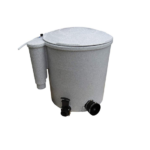Over the years we have had people comment: “I wish my Koi would talk and tell me if there is a problem?”
Well they do!
With the onset of most difficulties, there is a change in behaviour in advance which, if observed, can be used as an early warning system.
Some of these behavioural changes include:
- Unsociability
- Bottomed-out (Sitting)
- Lethargy
- Skittish (Unsettled)
- Use of fins (Single or both fins clamped)
- Flashing (Flicking)
- Abnormal gill movement
- Hanging around air/ water inlets Or gasping on the surface
Along with behavioural changes, physical changes can also give you an early indication of a potential problem.
Look out for:
- Changes to body shape (Swelling, lumps or bumps)
- Frayed, eaten or split fins
- Curvature of the spine (Bending)
- Change in mucus layer
- Raised scales
- Red ‘veining’ on the body or fins
- Change in faeces
- Skin blemishes, lesions, changes to lustre or colour
Not all behavioural or physical changes mean that there is a problem that affects all or even any of your Koi. Like Humans, your Koi can have ‘off-days’, it may be due to ‘stress’ from the cat next door or a slight temperature variation, feed etc. The best course of action is not to panic and for the next few days, just remain observant and investigate or seek help if symptoms worsen or increase. If symptoms do not improve it is then advisable to try and investigate the cause or call us for advice.
Making a correct diagnosis, without guessing at the cause is very important, as some of the time there is only one opportunity to treat the problem. After working at pondside on fish disease diagnostics for years, we have seen the results of when a Koi Keeper has incorrectly diagnosed a problem or just guessed at the cause. The results can range from a minor increase in the problem, to loosing all the Koi in the pond. As an example, if you medicate when it is a toxicity problem, the fish will deteriorate fast and you may well experience mortality. In diagnosing the problem, you must always look for the principal factor(s) and answer the question “why has the Koi become ill?” rather than looking at just treating the symptoms. If you can find out the original reason for the difficulty beginning then you can use this to solve the problem and prevent it from happening again in the future. For example, if during diagnosis a mucus biopsy (mucus scrape) was conducted and parasites were found, then the next step would be to find out why they are there? One of the causes of parasites can be poor water quality, if you treated for parasites without improving the water quality first, then you would be making the water more toxic which could lead to mortalities.
Over the years of pond visits we have found that following the steps of the framework below, will allow you diagnose any problem.
| 1. History |
|
| 2. Examination of the Koi |
|
| 3. Water Quality Testing |
|
| 4. Careful examination of the Pond, Filtration & Air Supply. | |
| 5. Examination of the Local & Adjoining Environment (Including Filters) |
|
Before treating the Koi, you must always undertake a diagnosis. This is a deduction as to the cause of the problem, supported by firm evidence. If you are not sure of the problem don’t treat!
There are seven principal factors which cause disease and mortality in fish. These are:
- Water toxicity
- Parasitic
- Bacterial
- Viral
- Internal organ failure
- Mechanical damage/ external stress
- Predators
By investigating all the stages mentioned and undertaking clinical examinations, sampling, biopseys, blood sampling and toxicology & pathological testing, it is usually possible to accurately determine the cause of the problem.
Primary Cause of Koi Health Problems
Over the years we have conducted many pond visits, where there has been a Koi health issue, the primary causes have been compiled to show which problems are more common.

Water toxicity, organic content and medication overdoses all come under water quality problems, which in total account for over half the total problems.
If you also take into account that parasites (unless introduced by new Koi) mainly become a problem when water quality declines, then you could say that water quality roughly equates to 80% of problems. Although these figures were combined from visits that were conducted many years ago, the general trend of occurrences are still very similar today. The five step framework for diagnosing a health problem, mentioned above, has been compiled so that by conducting the earlier stages, the most common causes will be confirmed or eliminated as possibilities first. Towards the later stages of diagnosis, the most common causes will already have been eliminated and you will now be looking at the more rare and unusual occurrences.


